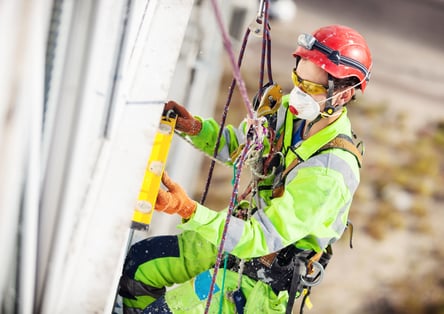
Fall protection ranks as one of the most frequently violated OSHA standards with nearly $20 million in citations as of 2014. And even more disturbing, the leading cause of worker deaths on construction sites was falling on the job. Protecting workers from potential falls is serious business. In fact, it's so serious that the ANSI standards Z359 are so in depth that most people will never really understand it entirely. Unfortunately, most will never even know they are even in violation until it’s too late. From fall arrest equipment and fall protection programs, to work positioning systems, work restraint systems, and rescue equipment, there are constant changes and advancements in fall protection equipment. Which is pretty much one of the biggest reasons for continuous fall protection training.
Let’s try to break it down.
Do You Know Your Fall Protection Basics?
Personal Fall Arrest Systems (PFAS) are made up of 4 major components:
- Anchor: Pretty self explanatory. This is your secure point of attachment that will support an intended load.
- Body Wear: Think harness. This is typically the support device that will help distribute force over multiple points of the body (upper thighs, pelvis, chest and shoulders).
- Connectors: Basically the lifeline that connect a worker’s harness to the anchor.
- Descent & Rescue: This is the device you will need to help raise or lower a worker to safety in an emergency.
Here are some examples of great products:
- Concrete Anchors- Designed for use in concrete, these reusable anchors have a compression strength of at least 3,000 psi. Constructed of stainless steel, aluminum and other non-corrosive materials, these anchors can be used on vertical or overhead applications.
- Miller Duraflex Python® Ultra Harnesses- Constructed with cushioned tubular webbing in shoulder straps to enhance comfort around neck and shoulders when required to wear a tool belt. The comfort-touch back D-ring pad is made with woven, breathable fabric for even greater comfort.
- Rebel® Cable Self-Retracting Lifelines- This lightweight and durable lifeline is safer than traditional lanyards due to retractable technology to ensure falls are stopped within a few inches. The aluminum or thermoplastic housing is rugged and can withstand rough use and has a unique speed- sending brake to keep forces to a minimum.
- Peakworks Confined Space Kit- Complete 7' tripod system features a built in pulley located above the head assmbly for superior operator balance and increased head room in confined spaces. Made with high strength construction, this kit can withstand the required 5,000 lbs. of vertical pull. Also includes a recovery style SRL with 60' of galvanized cable and steel swivel snap hook.

Training is key to effective fall protection
Creating a safe work environment is priority #1. When a workplace or jobsite has the potential for a fall-related accident, you MUST ask these important questions:
- Is equipment regularly inspected for safety and quality?
- Are you in compliance with standards?
- What are the potential risks associated with the site?
- Has a rescue plan been developed and put in place?
- Does your company offer regular PPE training?
It's not enough to just use fall protection properly. Understanding the device and how it operates, as well as having a plan to deal with any potential malfunctioning issues is crucial for optimum safety. Real life doesn’t play out according to some rule book, especially when the challenges and risk factors change on a day to day basis.
When working with elevators – installation, maintenance, or repair – the risk factors remain pretty much the same but depending on the job site, there may be more risks to consider. So plan for them. Regular training on how to use various fall protection devices and what to do in the event of gear failure will take the guesswork out when dealing with a life or death situation.
Safety: It's Your Life, It's Our Business.







